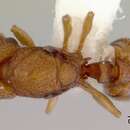en
names in breadcrumbs


Figures 1 - 25
Mayriella Forel, 1902: 425.
Diagnosis. Workers of Mayriella may be separated from other members of the Myrmicinae by the presence of a 10 - segmented antenna with a 2 - segmented club; well developed antennal scrobes; the clypeus with the mediolateral regions concave and the anterior margin with a bidentate process (these structures combining to form an extension of the scrobes which receive the terminal segments of the antennae when the antennae are retracted); and elongate compound eyes which are narrowed anteroventrally. These characters, especially the shape of the eyes and the configuration of the clypeus, are distinctive within the subfamily and it is unlikely these ants will be confused with close relatives.
Род был описан А.Форелем (Forel, 1902) по рабочим из Австралии (Квинсленд). ВМ. Вилер (Wheeler, 1935) привел переописание рода по рабочим и самкам, а также описал M.spinosior и два новых подвида M.abstinens Forel, subsp. hacken и subsp. venustula (все из Квинсленда); в этой же работе видовое название M.overbecki V і e hmeier, 1924 рассматривается как синоним M.abstinens Forel, 1902. Ч.Барони Урбани (Baroni Urbani, 1977) описал первый из Северного полушария вид рода - M.transfuga (Непал; Бутан). Описываемый нами новый вид - первый представитель Mayriella в Юго-Восточной Азии. Самцы Mayriella неизвестны.
Taxonomy. The genus Mayriella was established under the tribe Meranoplini by Forel (1902), but was placed in the Carebara genus group of the tribe Solenopsidini by Bolton (2003). The genus was recently revised by Shattuck & Barnett (2007). The worker of the single known Vietnamese species has the following features.
Worker monomorphic; head in full-face view subtrapezoidal; frontal lobe large; antennal scrobe very deep, surrounded dorsally by frontal carina and ventrally by genal carina; both carinae well developed and meeting at posterior end of antennal scrobe; median portion of clypeus behind anterior margin vertical or nearly vertical, terminating above in a projecting, bidentate appendage; median clypeal seta absent; posteromedian portion of clypeus inserted relatively broadly between frontal lobes; mandible with 4 teeth; antenna 10-segmented, with 2-segmented club; eye large and elongated, narrowed anteroventrally; mesosoma short and high; promesonotal dome flattened, slightly higher than anterior border of propodeal dorsum; humerus bluntly expanded anterolaterad; promesonotal suture absent dorsally; ventrolateral margin of promesonotum and anterior margin of mesopleuron forming flanges partly overhanging forecoxa; metanotal groove shallowly impressed dorsally; dorsum of propodeum declining posteriorly; propodeal spine elongate-triangular; propodeal lobe strongly expanded posterodorsad; petiole short but pedunculate, with high node; subpetiolar process well developed; postpetiole short; gastral shoulder well developed; dorsa of head and mesosoma with sparse, long, standing hairs.
The worker of Mayriella is somewhat similar to that of the Vietnamese species of Calyptomyrmex (for distinguishing features see notes under Calyptomyrmex ).
Vietnamese species. Only one species has been described from Vietnam: granulata Dlussky & Radchenko [= sp. eg-1; = sp. 1 of SKY: Yamane et al. 2005] (type locality: Bai Tu Long; other localities: Ba Be, Cuc Phuong, Phu Quoc, Tay Yen Tu, Van Ban).
Bionomics. Nests of M. granulata are found in rotting twigs, under stones and in the litter layer.
Mayriella is an Indo-Australian genus of ants in the subfamily Myrmicinae. Colonies in this genus are very small, typically consisting of 50 - 100 individuals.[2]
Species of this genus are encountered in moist forested areas, where most specimens have been found in wet regions, while some species have been found in dry sclerophyll areas, although this is usually uncommon.[2] Colonies only consist of 50 - 100 individuals, and nests are found in soil, typically under stones or around a small mound that contains an entrance.[3] Ants of this genus contain stings.[4]
Mayriella is an Indo-Australian genus of ants in the subfamily Myrmicinae. Colonies in this genus are very small, typically consisting of 50 - 100 individuals.